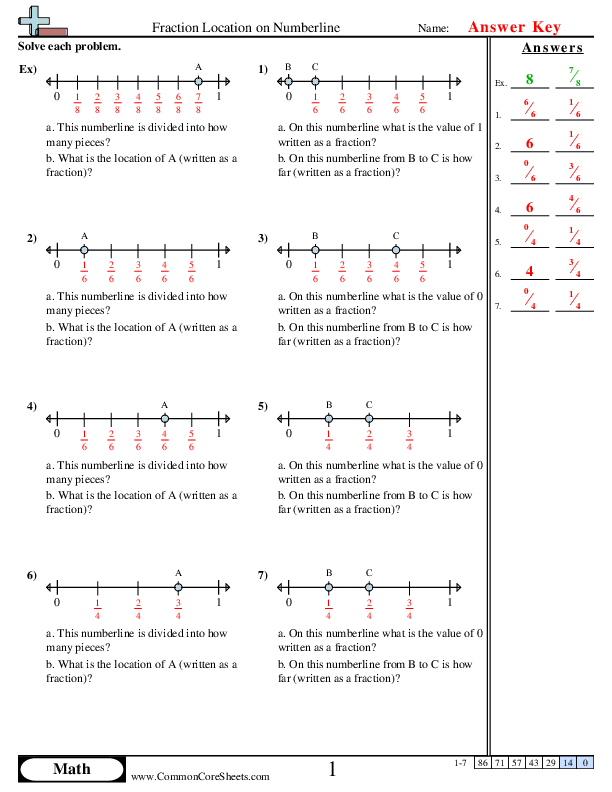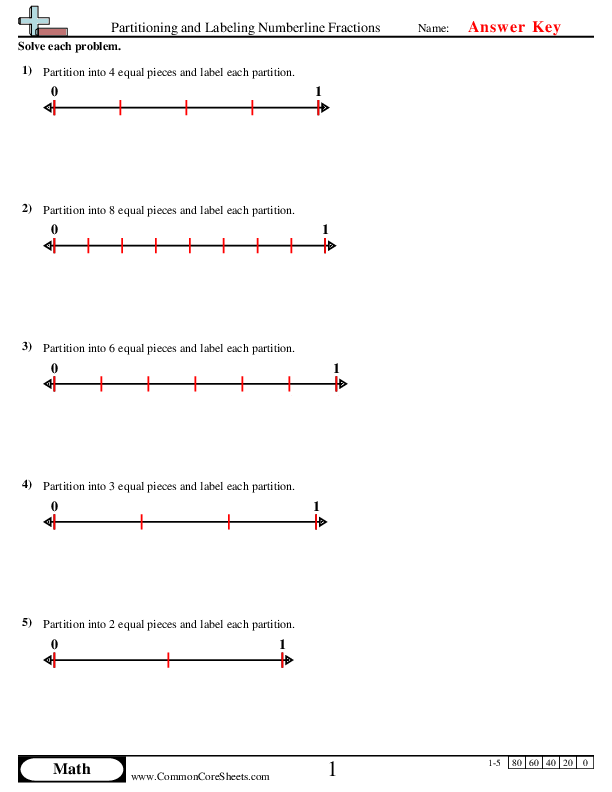Our fraction worksheets are the best on the internet! These free worksheets are perfect for students of all ages who are learning or reviewing fractions. Our fraction worksheets cover a range of skills, from simplifying fractions to adding and subtracting fractions with different denominators. Each worksheet includes clear instructions and plenty of space for students to show their work. With our fraction worksheets, you'll find everything you need to help your students master this important math concept. So why wait? Try our fraction worksheets today and see why they're the best on the internet!
Browse Sheets By Problem Type
×
Fraction Location on a Numberline

Finding Fractions on Number Line
3nf2a


×
Description:
"This worksheet is designed to help children master the concept of fraction location on a number line. Offering 8 diverse problem sets, kids identify the correct placement of specific fractions. The worksheet is highly customizable to suit different learning requirements. It can be easily converted into flashcards for more interactive learning or utilized in distance learning platforms to facilitate math education beyond traditional classroom settings."

×
Student Goals:
Understand FractionsBy completing the worksheet, students should gain a solid understanding of fractions. This foundation will be crucial for them to grasp more complex numerical concepts in the future. They'll learn about number numerators and denominators, as well as how these components influence a fraction's value. The task demands students to visualize fractions on a number line, which helps them appreciate the relative sizes of different fractions and their relation to whole numbers. This understanding can then be applied in various real-life scenarios, such as measuring ingredients for cooking or calculating distances.Develop Problem-solving SkillsThe worksheet serves as an excellent tool for enhancing students' problem-solving abilities. Each problem poses a unique challenge that requires students to apply their knowledge and analytical skills to find the required fraction on the number line. Through this process, they learn to approach problems methodically, improve their critical thinking skills, and, most importantly, do not fear facing mathematical tasks. These problem-solving abilities are not only relevant to their math lessons but are also applicable to other subjects and real-world situations.Enhance Numerical LiteracyCompletion of this worksheet means that the students have enhanced their numerical literacy. This implies that they've been exposed to the skills necessary to interpret and work with numbers in all aspects of life, from budgeting to measuring and beyond. They'd understand how fractions fit into the broader picture of numerical literacy, appreciating their prevalence and relevance in daily undertakings. Importantly, this stage of numerical literacy is a stepping stone towards more difficult concepts, such as percentages and ratio calculations.Improve Visual-spatial UnderstandingWith a focus on mapping fractions on a number line. This worksheet promotes visual-spatial understanding. It trains students to mentally arrange and manipulate numbers and fractions within a defined space. It also challenges them to identify the relative positions of different fractions on the number line. Consequently, this understanding aids in the honing of spatial awareness which is beneficial in other areas of education such as geometry, engineering, physical sciences, and even day-to-day tasks that require spatial judgement.Boost Confidence in MathematicsLastly, upon completion of the worksheet, students should feel a lot more confident in their mathematical abilities. By mastering these foundational fraction-related tasks, they will realize that they are fully capable of understanding and conquering mathematical challenges. This new-found confidence can have a profound effect on their overall attitude towards learning and education, encouraging them to tackle more complex mathematical problems and concepts without hesitation.



Determining Fraction Value on a Number Line
3nf2b


×
Description:
"This worksheet is designed to enhance children's understanding of fractions on a number line. Comprised of seven detailed math problems, it walks students through various aspects of fractions, including values and locations. The problems challenge students to identify fractional values and distances between points on various number lines. Adjustable for different learning levels, the worksheet can be customized, used as flashcards, or incorporated into distance learning curriculums to adapt to learning preferences and needs."

×
Student Goals:
Develop Numeracy SkillsAfter completing the worksheet, students will have greatly developed their numeracy skills. They will be capable of interpreting and locating fractions on a number line, a crucial concept in elementary mathematics. This understanding will be beneficial in the advancement of more intricate mathematical ideas and proficiencies in the future.Understand Division of Unit LengthsThe children will demonstrate an understanding that a number line is divided into unit lengths, and that different fractions or decimal points denote these divisions. Recognizing this foundational principle will enhance their skills in deeper mathematical categories like algebra, geometry, and more advanced categories of arithmetic.Knowledge of Real World ConnectionsThrough the worksheet, students will gain an understanding of how fractions and their location on a number line relate to real world situations. This could be in measuring distances, cooking, or understanding timelines, reinforcing the notion that math is not merely a theoretical subject, but has practical, everyday applications.Enhancement of Critical ThinkingThis worksheet encourages critical thinking and problem-solving abilities. From figuring out the value of points on a number line to comparing distances, students are challenged to think, analyze, and solve which fosters a much-required mindset for future mathematical and scientific learning.Effective CommunicationBy describing the location of various points on the number line as fractions, students will be developing their ability to communicate mathematical ideas and arguments effectively. This skill is vital not only in the scope of mathematics but also across different subjects and learning areas since clear communication is key in academic success and future professional pursuits.Improve AccuracyThrough repeatedly answering the problems provided, the children will improve their mathematical accuracy. This practice will lessen the probability of committing errors in calculations, which is a valuable skill in many areas of life requiring financial or statistical analysis.



Partitioning and Labeling Numberline Fractions
3nf2a


×
Description:
"This worksheet is designed to help children grasp and master the concept of partitioning and labeling on number lines, demonstrating understanding of fractions. Comprised of five unique questions, students will partition number lines into 2, 3, 4, 6 and 8 equal pieces. It offers customizability for individual learning and can easily be converted into flashcards for an interactive experience. Moreover, it's perfectly suitable for distance learning. This worksheet illuminates math concepts, making them approachable and comprehensible."

×
Student Goals:
Understanding of Fractional ConceptsUpon completing this worksheet, students should have a solid understanding of basic fractional concepts. They will learn that a fraction represents a part of a whole and that different fractions can represent the same value (for example, 2/4 and 1/2). Understanding fractions is crucial as it lays the foundation for more complex mathematical concepts in the future.Proficiency in Partitioning NumberlinesThe worksheet also equips students with the skill to accurately partition number lines into equal segments. This ability allows them to visually represent fractions and better understand their underlying principles. Partitioning is a critical skill for understanding interval scale and shapes the students' ability to deal with both ratio and proportion.Improved Numerical Labeling SkillsAfter finishing the worksheet, students will have improved proficiency in labeling each partition on the number line with corresponding fractional values. This enhances their number sense, links fractions to linear measurement, and cultivates their understanding of the relative nature of number size. This skill directly feeds into the ability to interpolate in missing number sequences and handle data interpretation in graphical forms such as bar and line graphs.Enhanced Comparison SkillsChildren will develop the ability to compare fractional values by analyzing number lines. This can be a practical way for them to understand that with fractions, a bigger denominator does not necessarily mean a larger value – an essential principle that students often struggle with in early fractions work.Introduction to Equivalent FractionsThough it is not explicitly mentioned in the worksheet, students will begin to develop intuition for the concept of equivalent fractions. They may notice, for example, that partitioning a number line into 4 pieces and shading in 2 will visually look the same as partitioning into 2 pieces and shading in 1 (i.e., that 2/4 = 1/2). This preps them for later math instruction where equivalent fractions are formally introduced.Building a Foundation for More Advanced Fractional ConceptsFinally, this worksheet provides a strong foundation for the learning of more advanced fractional concepts in the future. When they understand where fractions come from and how they work on a number line, they will find it much easier to grasp operations with fractions like addition, subtraction, multiplication, and division.



Identifying Fraction Location on a Number Line
3nf3c


×
Description:
"This worksheet is designed to enhance a child's understanding of converting fractions to whole numbers, helping to solidify their base in math. Containing 16 diverse fraction problems, it allows students to visualize numbers and conceptualize fractions. This versatile tool can be customized to suit any learner's needs, converted into flashcards for interactive learning or adopted in long-distance learning scenarios. The perfect adjunct to any math curriculum, empowering smarter and efficient learning."

×
Student Goals:
Understanding of FractionsAfter completing this worksheet, students should have a strengthened comprehension of fractions as expressions of whole numbers. They would gain the ability to recognize and mark fractions on a numerical scale, understand their relative proportions, and visualize their equivalence to certain whole numbers. This solidifies their fundamental grasp on the concept of fractions, laying the groundwork for more complex mathematical computations.Ability to Convert Fractions to Whole NumbersStudents will develop the skill to convert fractions into whole numbers. They will learn that when the numerator and the denominator of a fraction are the same, the fraction amounts to the whole number one. This skill will be integral to their progression within the subject of math as they progress to more complex topics, like algebra.Mathematical ReasoningBy working through the problems on this worksheet, students will enhance their mathematical reasoning skills. They will make logical deductions to decipher the location of fractions along a number line, thus building their aptitude in quantifying fractions of a whole. Their ability to think critically, reason logically, and make accurate mathematical judgments will be greatly improved.Competence in Numerical RepresentationThis worksheet will train students to efficiently translate numerical data into visual formats. They will mark the location of various fractions on a number line, thereby converting abstract numbers into concrete, visual representation. This not only helps in enhancing their comprehension but also promotes their skills in data representation, an important competency in various academic and professional fields.Confidence in Handling FractionsLastly, by successfully completing this worksheet, students will have gained the necessary confidence to approach fraction-based problems. Fear or hesitation towards fractions is a common phenomenon among young learners. However, with practice and subsequent mastery of the topic, this anxiety can be mitigated. By building their knowledge and understanding, this worksheet will help foster the students' confidence, influencing not just their performance on future worksheets and exams, but also their enthusiasm towards learning.





